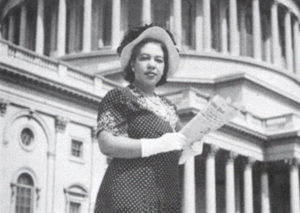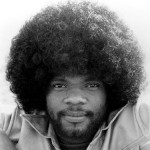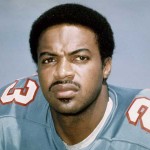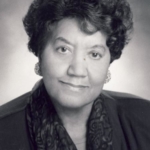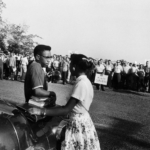Why Sarah Bird waited for decades to tell the story of a woman who enlisted in the Buffalo Soldiers
Image: Army painting imagining Cathy Williams, a.k.a. William Cathey, who enlisted in the Army in 1866. (U.S. Army/U.S. Army)
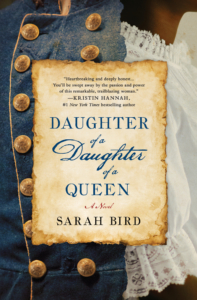 (Dallas News) It’s safe to call Sarah Bird one of the best writers in Texas. Just look at her bio, which is packed with accolades: Membership in the Texas Literary Hall of Fame. Recipient of the Texas Institute of Letters’ award for distinguished writers, the one they gave to the likes of Cormac McCarthy and Larry McMurtry.
(Dallas News) It’s safe to call Sarah Bird one of the best writers in Texas. Just look at her bio, which is packed with accolades: Membership in the Texas Literary Hall of Fame. Recipient of the Texas Institute of Letters’ award for distinguished writers, the one they gave to the likes of Cormac McCarthy and Larry McMurtry.
It’s safe to call her beloved, too. She had a six-year run as Texas Monthly’s back-page columnist, was voted winner of the Austin Chronicle’s Best Fiction Writer award six times and has even been turned into a hologram to welcome visitors to the fancy new Austin Central Library.
Bird’s reputation, at age 68, would seem to be secure. But as she sits down to talk at a cafe near her Austin home for an interview several days before the Sept. 4 launch of her 10th novel, “Daughter of a Daughter of a Queen” (St. Martin’s Press, $27.99), she’s worried.
It’s because Bird, who constantly cracks self-deprecating jokes but despises criticism — “I’m afraid of people not liking me” — is stepping into treacherous cultural terrain. She’s a white writer, in 2018, fictionalizing the story of a real African-American heroine: Cathy Williams, a one-time slave who, after the Civil War, disguised herself as a man and served with the Army’s legendary Buffalo Soldiers. (more)
First black female White House reporter to be honored with life-sized statue in D.C.
(Black Enterprise) A life-sized bronze statue is underway for Alice Allison Dunnigan, the first African American woman to receive press credentials to cover the White House. The sculpture is scheduled to be unveiled next month at the Newseum, an interactive museum based in Washington, D.C. that celebrates news history and is dedicated to underscoring the importance of a free press and the First Amendment.
Dunnigan, who began her journalism career in Kentucky before moving to Washington, D.C., was a pioneering journalist who rose to the top of her profession despite racist policies that segregated black journalists and sexist attitudes that severely limited opportunities for women in a male-dominated workplace.
Dunnigan was born in 1906 as the daughter of a sharecropper and a domestic worker. As a child, she dreamed of traveling around the world and reporting on her experiences as a newspaper writer. She landed her first writing gig at just 13 years old at a local newspaper where she wrote one-sentence news items. (more)
PVAMU grad:
Edward Guinn, Fort Worth’s first African-American city councilman ‘set the stage for all of us’
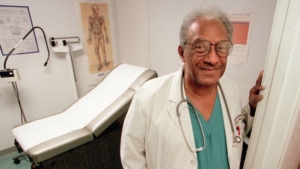
Dr. Edward Guinn, shown in this May 29, 2000, photograph at his practice in Stop Six. (File Star-Telegram)
He was Fort Worth’s first African-American city council member.
He also worked as a physician for more than a half-century, bringing healthcare to an underserved part of the city.
For some, Edward Guinn was an inspiration. For others, he was a mentor.
“Dr. Guinn literally paved the way for people like me to be able to serve the city I love,” said Fort Worth City Councilwoman Kelly Allen Gray, one of two African-American council members.
Guinn, 93, died on August 28. A private funeral service was held last Friday at Greenwood Memorial Park. (more)
TIPHC Bookshelf
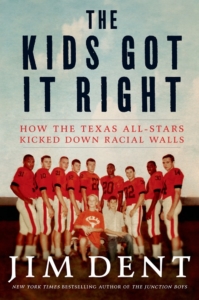 Published scholarship on black history in Texas is growing and we’d like to share with you some suggested readings, both current and past, from some of the preeminent history scholars in Texas and beyond. We invite you to take a look at our bookshelf page – including a featured selection – and check back as the list grows. A different selection will be featured each week. We welcome suggestions and reviews. This week, we offer, “The Kids Got It Right: How the Texas All-Stars Kicked Down Racial Walls,” by Jim Dent.
Published scholarship on black history in Texas is growing and we’d like to share with you some suggested readings, both current and past, from some of the preeminent history scholars in Texas and beyond. We invite you to take a look at our bookshelf page – including a featured selection – and check back as the list grows. A different selection will be featured each week. We welcome suggestions and reviews. This week, we offer, “The Kids Got It Right: How the Texas All-Stars Kicked Down Racial Walls,” by Jim Dent.
New York Times bestselling author Jim Dent pens the compelling story of how a black and white player came together to break the color barrier in Texas football in 1965. Jerry LeVias and Bill Bradley bonded as friends at the Big 33 high school all-star game, producing a dramatic finish that fans still talk about.
Dent takes the reader to the heart of Texas football with the incredible story of how two young men broke the chain of racism that had existed for more than half a century. In 1965, black and white players barely mixed in Texas. That summer, Jerry LeVias and Bill Bradley came together at the Big 33 game in Hershey, Pennsylvania. When no one else would room with LeVias, Bradley stepped forward. The two became the closest of friends and the best of teammates. LeVias called Bradley “my blue-eyed soul brother.” Big-hearted, gregarious, and free-spirited, Bradley looked out for LeVias – one of three black players on the team.
The Texas team came to Hershey with a mandate to win. A year earlier, Texas had lost to the Pennsylvania all-stars 12-6 in the most significant defeat in the state’s proud history. This was considered blasphemy in a place where football outranked religion. Texas coach Bobby Layne was mad-as-hell that he was forced to play with second stringers in ’64. So he and assistant coach Doak Walker traveled to Austin and asked Texas governor John Connally to end the scheduling conflict with the in-state all-star game so he could suit up the best players. Layne also sought permission to recruit black players. After all, Texas was flush with black stars, some of whom would mature into the most notable players in the history of the National Football League.
Layne’s scheme never would have worked without Bradley and LeVias. Together―and with Layne’s indomitable will to win―the two led their team proudly to face down the competition at Hershey Stadium. “The Kids Got It Right” is a moving story, reminiscent of “Remember The Titans.” Dent once again brings readers to cheers and tears with a truly American tale of leadership, brotherhood, and good-ol’ Texas-style football.
This Week in Texas Black History
Sept 2
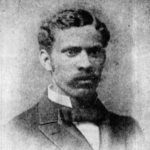 E.H. Anderson was born on this day in 1850 in Memphis, Tenn. Anderson would become the second principal for Prairie View State Normal School (Prairie View A&M University) in 1879. At the time, the school’s enrollment was only 50 students. During his tenure Prairie View experienced severe financial hardships as the Sixteenth and Seventeenth legislatures debated over the constitutionality and the funding of the school. The school did not have a fixed course of study, but toward the end of Anderson’s tenure he was optimistic at the support of the black communities around the state. Anderson died at Prairie View on October 29, 1885. He was succeeded by his brother, Laurine Cecil Anderson, who had served as his first assistant.
E.H. Anderson was born on this day in 1850 in Memphis, Tenn. Anderson would become the second principal for Prairie View State Normal School (Prairie View A&M University) in 1879. At the time, the school’s enrollment was only 50 students. During his tenure Prairie View experienced severe financial hardships as the Sixteenth and Seventeenth legislatures debated over the constitutionality and the funding of the school. The school did not have a fixed course of study, but toward the end of Anderson’s tenure he was optimistic at the support of the black communities around the state. Anderson died at Prairie View on October 29, 1885. He was succeeded by his brother, Laurine Cecil Anderson, who had served as his first assistant.
Sept 2
On this date in 1946, musician William Everett “Billy” Preston was born in Houston. A child prodigy, Preston began playing piano at age 3, was performing as an organist by age 10 for gospel singers such as Mahalia Jackson and touring with Little Richard at age 16. He became widely acknowledged as the “Fifth Beatle” having been the only party to ever have his name included in the label credits of the Beatles “Let It Be” and the “Abbey Road” albums as well as the landmark “White Album.” As a solo artist, Preston had a string of Number 1 hit singles including the Grammy-winning “Outta Space,” “Will It Go Round In Circles,” “Nothing From Nothing” and “Space Race.” He wrote the song “You Are So Beautiful” which was a multi-platinum hit for British blues singer Joe Cocker.
Sept 4
Multi-platinum, Grammy Award-winning singer Beyoncé Knowles was born on this day in 1981 in Houston. Knowles rose to fame as the creative force and lead singer of R&B girl group Destiny’s Child, the best-selling female group of all time, with over fifty million records sold. The multi-talented Knowles is also an dancer, actress, producer, fashion designer and model, and was twice-nominated for Golden Globe Awards for her performance in “Dream Girls” in 2006. In 2008, she married hip hop mogul Jay-Z and in 2013 was ranked by Forbes magazine among the most powerful celebrities in the world.
Sept 5
Football player Jerry LeVias was born on this day in 1946 in Beaumont. LeVias starred as a quarterback at Hebert High School, but became the first black scholarship athlete and second black football player in the Southwest Conference as a wide receiver in 1966 at Southern Methodist University. He was an All-America (athletic and academic) as a senior and twice led the league in receiving and left SMU with numerous school and conference career records. With the Houston Oilers, LeVias was selected to the 1969 American Football League All-Star Team. He is a member of both the Texas Sports Hall of Fame and the College Football Hall of Fame.
Sept 5
Dr. June Brewer was born in Austin on this day in 1925. Brewer was the first of five African-American women to apply for admission to the University of Texas Graduate School in 1950 after the U.S. Supreme Court‘s ruling on Heman Sweatt‘s admission. She was an English Professor at Huston-Tillotson College for 35 years and was Chairperson of the department, the first Endowed Professor (Karl Downs Professor of Humanities) and Professor Emeritus on retirement. She received a National Endowment for the Humanities Fellowship to conduct research on black women writers which became her teaching specialty. Brewer served on numerous Austin Independent School District task forces, including one for dropout prevention, and also founded a nonprofit organization, Borders Learning Community, which promoted closing the racial achievement gap, especially raising standardized test scores.
Sept 5
On this day in 1956, Texarkana Junior College was integrated when Jessalyn Yvonne Gray and Laura Ellis passed aptitude tests and were admitted to the school. Their acceptance set off a chain of violent protests and community-wide death threats against blacks by local white racists. A black-owned service station was blasted with shotgun fire, two crosses were burned and a black man was hanged in effigy hours after the 30-year segregation policy was struck down.
Blog: Ron Goodwin, Ph.D., author, PVAMU history professor
Ron Goodwin is an assistant professor of history at Prairie View A&M University. Even though he was a military “brat,” he still considers San Antonio home. Like his father and brother, Ron joined the U.S. Air Force and while enlisted received his undergraduate degree from Texas Lutheran University in Seguin, Texas. After his honorable discharge, he completed graduate degrees from Texas Southern University. Goodwin’s book, Blacks in Houston, is a pictorial history of Houston’s black community. His most recent book, Remembering the Days of Sorrow, examines the institution of slavery in Texas from the perspective of the New Deal’s Slave Narratives.
Recent Posts
Democratic Party – Fifty Years Later
In 1968, the Democratic Party met in Chicago to nominate its candidate for president. The Party was in chaos after the violent deaths of Robert Kennedy and Martin Luther King, Jr. While King was not an acknowledged political figure, his non-violent social stance and his views on American involvement in Vietnam was influencing public policies. Perhaps more influential in the forthcoming implosion of the Democratic Party was the death of Robert Kennedy. (more)
Television — Fifty Years Later
Social pundits often consider 1968 a pivotal year in our democracy. Fifty years later, the deaths of Martin Luther King, Jr. and Robert F. Kennedy have many liberals questioning how compassionate our democracy may have been had they lived. There is no doubt they would have made a powerful one-two punch in eradicating many of the social ills caused by uncontrolled capitalism. Fifty years later we are also dealing with the implosion of the Democratic Party at its national convention and the unexpected return of Richard Nixon via the now vaunted Southern Strategy. (more)
Submissions wanted
Historians, scholars, students, lend us your…writings. Help us produce the most comprehensive documentation ever undertaken for the African American experience in Texas. We encourage you to contribute items about people, places, events, issues, politics/legislation, sports, entertainment, religion, etc., as general entries or essays. Our documentation is wide-ranging and diverse, and you may research and write about the subject of your interest or, to start, please consult our list of suggested biographical entries and see submission guidelines. However, all topics must be approved by TIPHC editors before beginning your research/writing.
We welcome your questions or comments. Please contact Michael Hurd, Director of TIPHC, at mdhurd@pvamu.edu.

